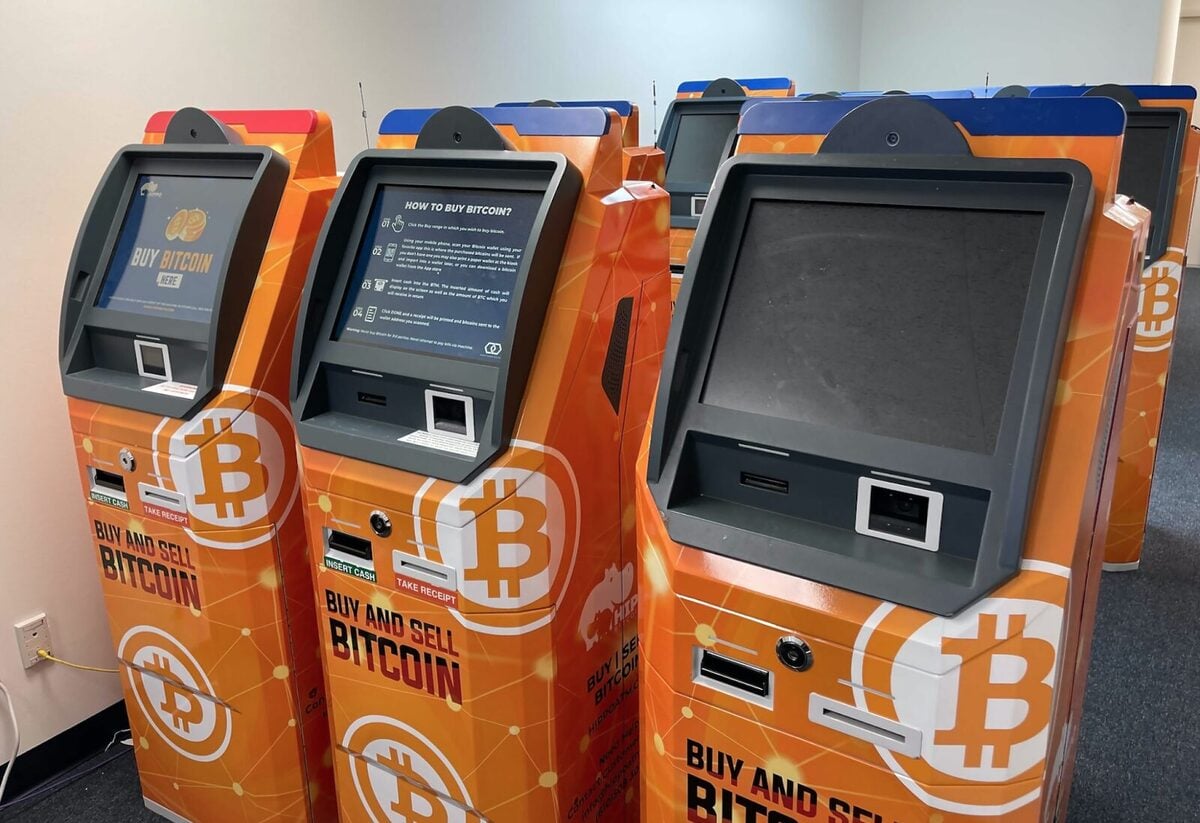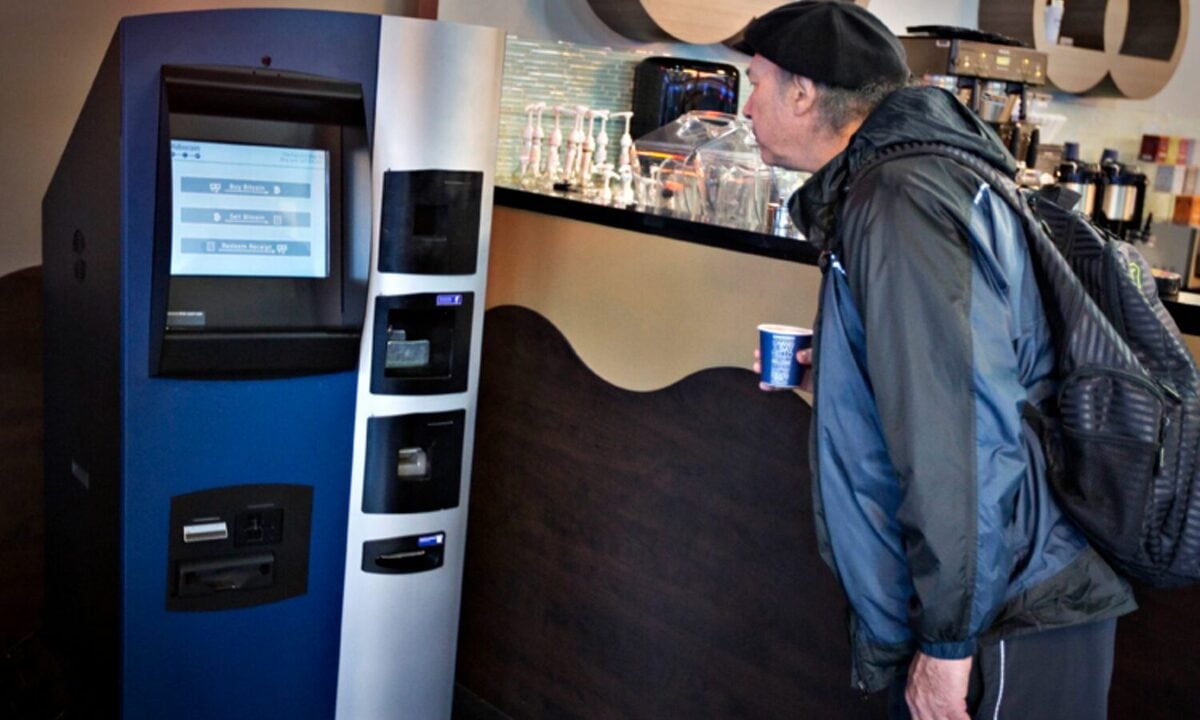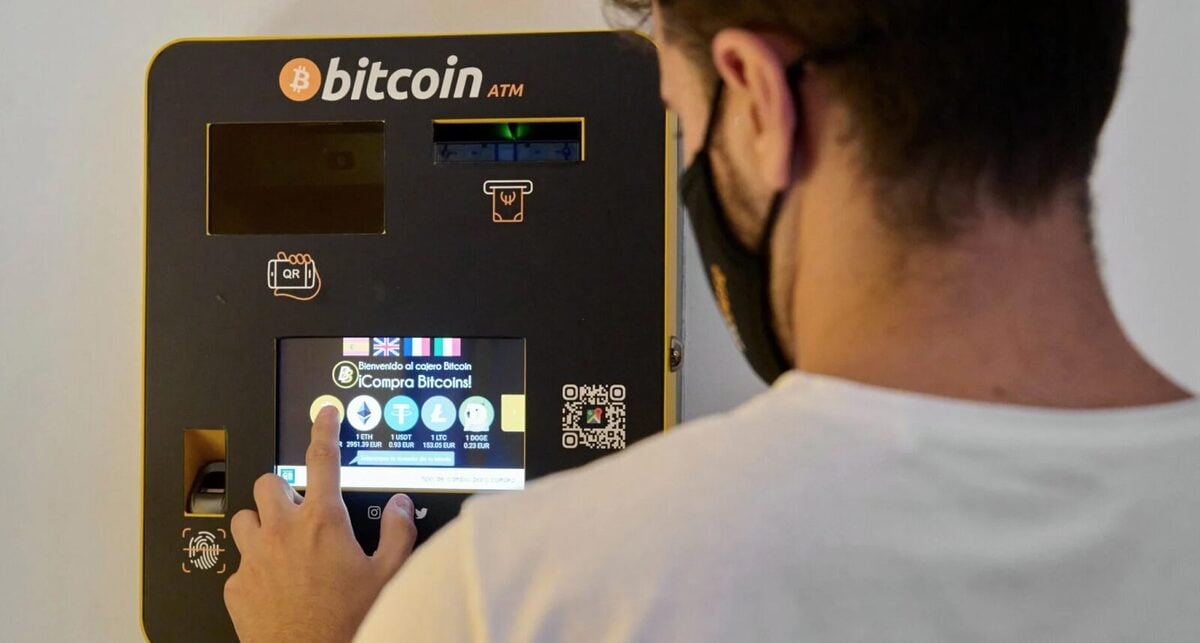What Are Crypto ATMs and How Do They Work?
Though crypto can sometimes seem technical and complex, cryptocurrency ATMs make buying and selling digital currency much more straightforward.
These handy machines can appear in all kinds of public spaces. Therefore, it’s certainly not a bad idea to learn how they work if you purchase some tokens while out and about with friends or family.
Sponsored
However, while we’re all familiar with traditional fiat ATMs, are crypto ATMs that much different? And, more importantly, how does someone use one for the first time?
Table of Contents
- What Is a Crypto ATM?
- The First Crypto ATM
- How Do Crypto ATMs Work?
- How to Use a Crypto ATM
- How Much Identification Do Crypto ATMs Require?
- Crypto ATM Fees
- Are Crypto ATMs Safe to Use?
- Pros and Cons of Crypto ATMs
- Benefits of Crypto ATMs
- Drawbacks of Crypto ATMs
- Regulatory Status of Crypto ATMs
- Where to Find Crypto ATMs
- On the Flipside
- Why This Matters
- FAQs
What Is a Crypto ATM?
 Source: Scottishfinancialnews.com
Source: Scottishfinancialnews.com
A crypto automated teller machine (ATM) is an electronic kiosk that allows people to buy and sometimes sell Bitcoin (BTC) and other cryptocurrency on the go.
On the surface, they can look almost identical to traditional ATMs, but there are two key differences to know.
The first and most obvious difference is that these ATMs accept both fiat money and crypto, not just fiat like their counterparts.
Though Bitcoin-specific ATMs (BTMS) are very popular, others support a range of other tokens, such as the ATMs hosted by General Bytes and ForumPay.
The second major difference is that crypto ATMs don’t connect to a person’s bank account. Instead, they will pair up with the customer’s cryptocurrency wallet, where you can store crypto or any other assets after purchasing them.
The First Crypto ATM
The first crypto Bitcoin ATM appeared in 2013 at a coffee shop in Vancouver, Canada. It was operated by a remittance service called Robocoin.
 Source: Dawn.com
Source: Dawn.com
Since Bitcoin had only launched four years before, this was way before cryptocurrency would enter the mainstream. Therefore, this single ATM seemed pretty peculiar, but it was a project that ultimately paid off, with 348 transactions worth over $100,000 occurring in the first week alone.
Since then, crypto ATMs have steadily gained more popularity, especially in the US, with over 31,000 active machines.
How Do Crypto ATMs Work?
When you use a crypto ATM, it can be difficult to identify what mechanisms and systems are used behind the scenes when someone begins processing a transaction.
The truth is that crypto ATMs are connected to crypto exchanges—platforms that grant users access to crypto markets. This is where they retrieve the crypto that the customer is buying.
The transaction is then processed and stored on a blockchain, a digital ledger that tracks all crypto transactions for full transparency.
If any of this seems complicated, don’t worry; crypto ATMs won’t require you to dig into exchanges or blockchains yourself – all you need to do is choose your token of choice.
How to Use a Crypto ATM
 Source: Gizmodo.com
Source: Gizmodo.com
Stepping up to a crypto ATM for the first time can be nerve-racking, but buying crypto again is an absolute breeze once you’ve used it.
Here’s a step-by-step guide to using a crypto ATM, including what you’ll need to bring with you:
- Acquire a Crypto Wallet: Cryptocurrency wallets are readily available as both website extensions and mobile applications. They’re easy to sign up for and don’t require too many personal documents, especially if they’re non-custodial . Write down the wallet address, as this will be needed later.
- Find Your Closest ATM: Sites like CoinATMRadar will highlight ATMs near your location. While Bitcoin ATMs are fairly easy to find, ATMs supporting altcoins might require extra traveling.
- Verify Your Identity: Upon booting up the machine, you will be asked to verify your ID. This will usually only be a phone number, but some kiosks require photo identification or a social security number.
- Register Your Wallet: Now it’s time to sync up your wallet so you can start buying. This is done by scanning the QR code alongside your wallet address, though some ATMs will let you manually type in the address.
- Select a Token: Bitcoin ATMs will only allow you to buy Bitcoin, but for altcoin ATMs, customers can choose from a selection of tokens to purchase or tokens from their own digital wallet to sell.
- Deposit/Withdraw Money: Unlike a traditional ATM, which withdraws money, crypto ATMs will require money to be deposited into the small, thin opening either at the side or bottom of the machine. If you’re selling crypto, then the money will be withdrawn instead, just like a regular ATM.
- Await Confirmation: The transaction will now be complete. However, make sure not to leave the machine until you either receive a confirmation on the screen or a receipt. You can also double-check your wallet if you have it on mobile, just to make sure.
How Much Identification Do Crypto ATMs Require?
Crypto ATMs require a phone number as the bare minimum of identification as part of their KYC (Know Your Customer) compliance, but photo identification and a social security number are also common requirements.
It should also be mentioned that ATMs selling crypto tend to require more ID than those solely focused on buying. To be safe, it can be worth writing down your important verification numbers and even keeping ID documents like a driver’s license handy as a precaution.
Crypto ATM Fees
Buying and selling crypto, whether on an exchange or through a crypto ATM, always involves a transaction fee.
Admittedly, this fee is often much higher on ATMs, ranging between 4% and a staggering 20% in some cases, primarily for big orders.
If we take CoinFlip for example, their ATMs come with a buy fee of between 6% and 10%, which is already higher than most exchanges . Bitcoin Depot’s ATMs, on the other hand, can charge up to 20% but are much more popular and accessible.
Though this might seem excessive, it is simply the cost of making something convenient. For example, if you’re self-employed, you can save the hassle of adding up your taxes and collecting all the paperwork by paying a tax accountant to do it for you.
This is exactly the same with crypto ATMs which will navigate the market and blockchain technology for you, in exchange for a higher trading fee.
Are Crypto ATMs Safe to Use?
Using any ATM always comes with a security risk since it requires interacting with your finances in a public setting.
Unfortunately, crypto ATMs have been just as susceptible to scams and bad actors as traditional ones. In 2023, the FBI reported that roughly $120 million had been lost from crypto ATMs due to scammers.
It’s, therefore, crucially important to make sure you follow proper security procedures to keep your funds safe and secure. Here are a few key considerations to keep in mind:
- Bring a friend to ensure nobody that your activity is protected from onlookers.
- Never respond to anyone who purposely tries to direct you to a crypto ATM; legitimate companies would never do this.
- Always ensure that a transaction has been fully processed before leaving the machine.
Pros and Cons of Crypto ATMs
We’ve already briefly discussed some of the major benefits and drawbacks of crypto ATMs, so let’s examine them in more depth so that you can determine their reliability and efficiency.
Benefits of Crypto ATMs
- Convenience: Crypto ATMs allow traders to buy or sell crypto on the go, meaning you could easily purchase a sum of Bitcoin while shopping, for example. Additionally, the minimal amount of ID that’s required makes it simple and easy to start trading.
- Ease of Use: Additionally, crypto ATMs are automatically connected to a crypto exchange, meaning users don’t have to sign up for one themselves. This makes crypto ATMs especially accessible for newcomers.
- Public Adoption: Having these machines dotted around bars, gas stations, restaurants, and other public spaces helps bring more recognition and acceptance to cryptocurrency, which could relax regulation laws on ATMs, making them less strict with verification.
- Instant Transactions: Bitcoin ATMs allow for instant transactions, essential for those who enjoy capitalizing on price fluctuations in real-time.
- Financial Inclusion: For those without access to a bank, crypto ATMs offer an alternative option that can be accessed with cash in hand and a crypto wallet.
Drawbacks of Crypto ATMs
- High Fees: Crypto ATM fees are higher than those found on exchanges and typically range between 5% and 20% when buying, though it’s still possible for big transactions to exceed 20%.
- Transaction Cap: Most ATMs will have a minimum and maximum transaction limit. This means that users are essentially made to start spending real money right from the get-go rather than spending a tiny amount to get familiar with the machine first.
- Price Markup: Some ATMs will markup the price of their tokens, meaning that the actual value of the token will be bumped up anywhere from 8% to 15% on average. Though this isn’t the case with every ATM, it can still be a lot when stacked on top of the transaction fee.
- Security Risks: As with traditional ATMs, there’s always going to be a security risk when managing any kinds of assets in public. Therefore, bringing a friend along and checking the legality of a machine to ensure it hasn’t been tampered with are both measures that should be taken.
Regulatory Status of Crypto ATMs
Just like cryptocurrency itself, crypto ATMs occupy somewhat of a gray area in terms of legal regulations.
Internationally, this has resulted in some countries taking a firm stance and others being more accepting. For example, in September 2024, the FCA closed down over 2000 crypto ATMs in the UK operated by GidiPlus, and now there are no legal crypto ATM operators in the country.
However, America has established a more structured regulatory framework for crypto ATMs. By federal law, all crypto ATMs must register with the Treasury Department’s FinCEN, prompting them to monitor their machines for suspicious activities.
In addition, individual states decide whether ATMs will require a stricter identification process or whether they’re even allowed to function.
Where to Find Crypto ATMs
Since the very first crypto ATM made its debut in a coffee shop, it makes sense why the majority of these machines can now be found in public spaces including bars, restaurants and diners.
However, there are definitely a few parts of the world that have been considered “ATM hotspots” where finding a crypto ATM is a much easier task:
- Los Angeles: 1,710 ATMs
- Houston: 1,339 ATMs
- Chicago: 1,120 ATMs
- Pittsburgh: 446 ATMs
- Hong Kong: 171 ATMs
- Warsaw: 86 ATMs
- Vienna: 51 ATMs
There are numerous online ATM map scanners that can help guide you to your nearest ATM. However, keep in mind that these can often differ in what they actually show. Therefore, check out two or three rather than just one to ensure accurate information.
On the Flipside
- Currently, Crypto ATMs have only gained mainstream adoption in the US, and even then, they are only concentrated in a few key states.
- This creates uncertainty as to whether they will bring greater adoption of crypto or if they may be clamped down on in the future due to regulatory issues.
Why This Matters
Not everyone wants to go through the hassle of loading up an exchange and learning about a blockchain just to buy some crypto.
Therefore, crypto ATMs are a convenient alternative for beginners and can also be used for quick trading by experienced investors.
FAQs
Bitcoin Depot is currently the most popular, with over 7000 machines internationally, while CoinFlip is second with over 4000.
The majority of Crypto ATMs only accept cash, though some also accept debit and credit cards for purchases.
Though there isn’t a dedicated Bitcoin wallet, most crypto wallets still support the token, excluding those primarily designed for specific networks, like MetaMask with Ethereum.
Disclaimer: The content of this article solely reflects the author's opinion and does not represent the platform in any capacity. This article is not intended to serve as a reference for making investment decisions.
You may also like
SEC Drops Fraud Case Against HEX Founder Richard Heart

Cardano Surges 17%, Eyes Potential $5 Target

SOL Strategies Secures $500M for Solana Validator Expansion

Ubisoft and Immutable Launch ‘Might & Magic’ on Ethereum

